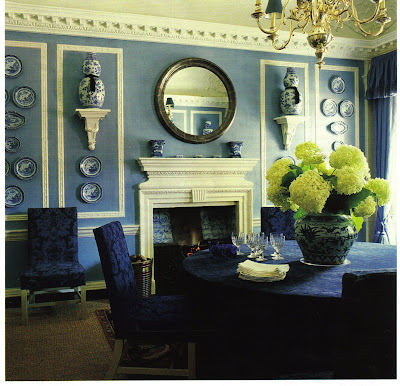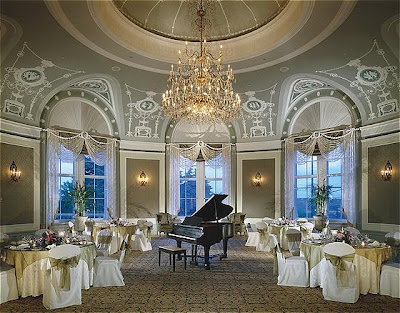
The card room adjacent to the formal dining room is going to be used to display our Wedgewood collection. It will be painted the same traditional colours of the Wedgewood plates, and like the plates we will make much of the plaster decoration on the blue backdrop...

Above: A Wedgwood ceiling panel in Dublin.

Above and below: Examples of plaster work with a Wedgwoodesque style. I love the fireplace above and it is going to be replicated in the room.


Above and Below: Other room ideas in similar shades of blue. We will use sconces and plastered niches to display our Wedgwood pieces.

Below: an antique card table of the type which will be centered in the room. Over it will be a chandelier hanging from an ornately plastered dome, such as the ceiling panel above.




Josiah Wedgwood (below), the founder of the famous pottery, started his career as an apprentice to Thomas Whieldon. In 1759 he leased Ivy House in Burslem from relative, which allowed him to start his own pottery business.
In 1765, Wedgwood created a new earthenware form which impressed Queen Charlotte (the wife of George III) enough to give him a royal warrant and permission to call it "Queen's Ware". In 1766 Wedgwood bought Etruria, a large estate in Staffordshire. It served both as a home and as a pottery site.
Wedgwood developed a number of industrial innovations for his company, notably a pyrometer (away of measuring kiln temperatures accurately), and new ware types Black Basalt and Jasper Ware - the familiar style of white decoration on darker matte pottery styled above. The first background colour was the the popular Poland Blue, which I still think is the most attractive. In total Wedgwood experimented with more than 3,000 colour samples.
The main decorative themes found in Wedgewood's jasper ware were taken from ancient mythology (Roman, Greek and Egyptian). This complimented well the architectural styles of neoclassiciasm and the Georgian decorative styles (as such it will compliment Willowbrook Park well too!).

Above: A fine example of a Jasperware urn.
Below: Jasperware panels beautifully incorporated into ormulu regency furniture.
Wedgwood had increasing success with hard paste porcelain attempting to imitate the whiteness of Chineese porcelain. The high transportation costs and the vigorous long journey from the Far East meant that the supply of china could not keep up with the increasingly high demand. In 1812 Wedgwood produced their own bone china. Though not a commercial success at first, Wedgwood's English Fine Bone China eventually became an important part of an extremely profitable business.
The company merged with Waterford in 1987. The joint company was placed under administration last year due to the financial crisis. Now many of the lines have been deleted and much of the pottery is to be made in asia.
Other rooms where Wedgewood has obviously been an inspiration...

 Above and below: Examples of plaster work with a Wedgwoodesque style. I love the fireplace above and it is going to be replicated in the room.
Above and below: Examples of plaster work with a Wedgwoodesque style. I love the fireplace above and it is going to be replicated in the room.
 Above and Below: Other room ideas in similar shades of blue. We will use sconces and plastered niches to display our Wedgwood pieces.
Above and Below: Other room ideas in similar shades of blue. We will use sconces and plastered niches to display our Wedgwood pieces.











































































beautiful idea -i'm such a fan of wedgwood, as you know. I can't wait to see how it (and everything) turns out!
ReplyDeleteThere's an auction this weekend in Massachusetts, (in which you can participate online, if you so desire), and it includes some rather pretty Wedgwood pieces, which I've just written about and in which I've made reference to your blog, which I'm very much enjoying reading.
ReplyDeleteColumnist suggested I read this and I have discovered a new blog (new to me, that is). I mentioned to him that in Birmingham, Alabama at the town museum is the best collection of Wedgwood outside of Britain but I realize that is quite a way for you to travel.
ReplyDeleteWhat a STUNNING blog! I'm completely hooked! I've only made it through a few posts so far, but am happy to pour a scotch, curl up in my favorite chair, and read your entire blog!
ReplyDeleteYour newest fan,
s.